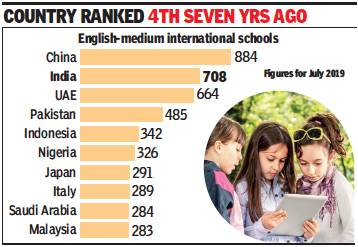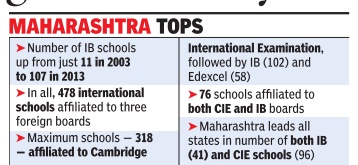International schools, International Baccalaureate (IB), India
This is a collection of articles archived for the excellence of their content. |
Contents |
International schools
2012> 2019: International schools double
Hemali Chhapia, Nov 18, 2019: The Times of India

From: Hemali Chhapia, Nov 18, 2019: The Times of India
India now ranks second in the number of international schools it hosts, right behind China — an improvement of two ranks since 2012, when it was placed behind the UAE, Pakistan and China. With middleclass parents in India largely opting for imported curricula, for reasons ranging from giving their children a shot at the Ivies and Oxbridge to social prestige, the count of international schools in the country has more than doubled in just seven years, with parents shelling out a combined $1.2 billion annually in tuition fees, data compiled for TOI by ISC Research shows.
While in 2012 India had 313 international schools, which enrolled 1.52 lakh children, in 2019, the numbers are 708 and 3.73 lakh, respectively. Also, local students now vastly outnumber expats, a demographic which these schools originally served. The nationality-wise break-up according to enrollment numbers is: 63.4% Indians, 5.2% Americans and 1.8% South Koreans, followed by students from scores of other countries, who are mainly the children of diplomatic officials and staff, and also from corporate families.
“As in many other countries, parents in India have high aspirations for their children’s education. There is growing recognition of the advantages that private education, including international education, can offer. However, most families have not been able to realise their aspirations because of prohibitive tuition fees,” said ISC Schools director Richard Gaskell. Little wonder then that several international schools have reworked their fees to attract more students. “The average annual fee of international schools in India is among the lowest in Asia, at $3,293,” said Gaskell. The corresponding average in China is $15,726, UAE $8,073, and Malaysia $6,395. The global average is almost thrice India’s, and stands at $9,242.
International schools with annual tuition fees between $4,000 and $10,000 had 18.8% of India’s total international school enrolment in April 2017, and those with tuition fees above $10,000 had 6%. A for mer Inter national Baccalaureate (IB) representative for South Asia, Farzana Dohadwalla, said, “Parents are feeling they don’t want their child to be a scared, nervous one in a class of 50 or 60. Class sizes in international schools are small. These schools help their students become mini-leaders, entrepreneurs, team members, risk-takers. They are not just super words, they are real learner profiles.”
The most prevalent foreign curricula in India are the Cambridge Secondary, Cambridge Primary and Cambridge Advanced programmes. The Cambridge Secondary programme is delivered in 56.6% of all international schools in India, with IGCSE being the most prevalent foreign examination.
The Podar Group of international schools, which has ten international curricula institutes, used to hold awareness seminars to explain how different these schools were from local ones. Now, they have a waiting list of hundreds of students. Principal and director Vandana Lulla said, “Indian parents are the most serious kinds who value education and are looking for access to quality education at an affordable price. Aspirational parents who can afford an international curriculum, which is application-based, belong to the middle class, which is large in India.”
Number of IB schools in India
IB schools in India: 2003-2013
The Times of India, May 20 2015
IB schools in India post 10-fold growth in 10 yrS
Akshaya Mukul
India may not have the Ivy League but it is fast getting an `IB league'. According to a new report, the number of schools with IB (International Baccalaureate) has grown nearly ten-fold in the last 10 years. In 2003, just 11 schools offered the IB programme. By 2013, this had gone up to 107, with Maharashtra leading with 41 schools.
It's not just IB; other international school programs have become more popular as well. The study conducted by the National University of Educational Planning & Administration said that as of 2013, there were 478 international schools affiliated to three foreign boards the Geneva-headquartered IB, Cambridge International Examination (CIE) and Edexcel, both based in the UK.
These are spread across 19 Indian states, with the highest number (318 schools) affiliated to CIE, followed by IB (102) and Edexcel (58). Seventy-six schools are affiliated to both CIE and IB. Maharashtra has the highest number of CIE schools as well at 96. One of the reasons for the growth of international schools has been the perception that they encourage creativity and free thinking, both important characteristics for success in a globalized world.Not surprisingly , the profile of the “international“ student has also changed. Earlier, the study notes, only children from expatriate families, business class and multinational professionals were going to international schools but now even middle class families are sending their children to these schools.
The study commissioned by the HRD ministry has suggested that the government initiate a policy framework for the establishment and regulation of international schools by setting up the In ternational Schools Regulatory Authority (ISRA).
The study has asked the government to clearly specify the essential attributes of an `international' school.For instance, more than 20% international mix of students and faculty could be one way of doing it.
2016: Only three pure IB schools
Swati Deshpande Aug 26 2016 : The Times of India (Delhi) IB school says it does not come under RTE
Lawyer Manisha Jagtap, representing the Centre, said there were eight to 10 IB schools in the state and they might seek similar relief. Sathe said there are “only three pure IB schools in the country . The rest are hybrid schools which opt for IB later and they are recognised also as a school with the state or central board. This is the basic difference“.
See also
Mercedes-Benz International School, Pune, especially for legal aspects of IB schools and the RTE.
